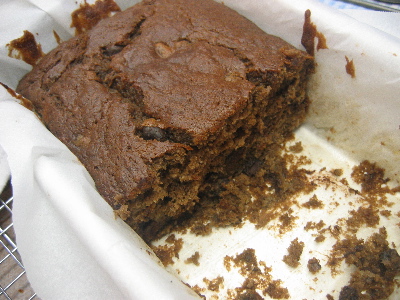I took the bread class at the local Sur La Table on Saturday. I gave the class 10 for information and fun, 7 for organization. It was a little disorganized, but I had a blast and I learned a great deal.
The class was taught by Stephany Buswell, a baker at Beckmann’s, a local bakery. When I bought bread—haven’t bought it for months! go me!—I bought Beckmann’s. We made walnut bread, focaccia, and cinnamon rolls and sticky buns from the same batch of sweet dough.
All of them: excellent. I’m not a big fan of nut breads, but the walnut bread was pretty tasty. And Darin bit into the focaccia, said, “Wow, I don’t usually like focaccia, but this is great!” and proceeded to rip a huge bit more off. And the cinnamon rolls—note to Rob and Laura: these were the rolls I wanted to make for breakfast that morning. I will try again! I have practice now!
We were grouped into threes. The other woman in my trio was also the mother of a five-year-old and a three-year-old, which I found amusing. She’d had problems with making bread in the past, because it always came out too dense. The curse of homemade bread! Too much flour. In fact, I usually err on the side of having too liquidy a dough, figuring I’m going to add more during the folding process.
The last member of our threesome was a guy who’d obviously made lots of breads: he knew how to knead. Me, I ended up with hands covered with dough, but man, this guy knew how to work it. (Key tips: keep fingers out of it. Only use palms. And lift and turn the dough frequently so it doesn’t glom onto the board.)
So I learned a lot about what properly kneaded dough should look like (I’ve been pretty close, but I’ve often not kneaded enough), how to roll bread and form a boule, how to form one of those cool windowpanes, how to properly flour your working surface (you sort of pitch from the side—Stephany was amazing the way she could poof the flour over the board), and how to scatter rosemary on focaccia bread. Okay, that last one wasn’t so hard.
§
I have finally settled on my favorite white sandwich bread recipe, and it comes from my current favorite cookbook, How to be a Domestic Goddess. It’s Nigella’s “Essential White Loaf” recipe, and it’s just great. It’s the only white bread recipe I’ve made that contains no sugar (shout out to Bakerina) and it’s insanely moist, undoubtedly because of one of the additions: instant mashed potatoes! Actually, Nigella recommends using “potato water,” but if you don’t have that around, use instant mashed potatoes.
I made this bread for the first time last Sunday—we are currently on loaf #5. It’s crazy. But it’s unbelievably delicious. It’s the first recipe I made that has reliably come out as sandwich bread size, and with yummy moistness. Check it out (directions mine, since I’ve gotten into the bread-making groove now):
3 1/2 cups white bread flour, plus more for kneading
1 tablespoon fresh yeast, or 1 package rapid rise yeast
1 tablespoon salt
1 1/3 cups warm water
1 tablespoon instant mashed potatoes, added to water
1 tablespoon unsalted butter, softened1. Mix flour, water, potato, yeast.
Autolyse.2. Add salt and butter. Knead.
3. First rise.
4. Preheat oven to 425F.
5. Punch-down and shape into a 9×5 loaf pan.
6. Second rise.
7. Bake for 35 minutes. Check for doneness. Take loaves out of their pans, put on oven rack for another 5 or so.
Update 5/19/05: For a few weeks, I thought the bread I was making had suddenly become way too dry, and I’ve decided the problem was that I was letting the sponge sit too long (for the sponge I mixed everything except half the water and the salt, I think). So I went back to mixing everything together, no autolyse, and kneading until I get the gluten window, not necessarily until the dough makes a nice tight ball. In fact, the dough is usually still a little goopy and sticky when I put it in the proofing bucket. I figure I’m going to add more flour when I shape the dough into the pans for the second rise anyhow, and I’d rather have underfloured dough than overfloured (which leads to tough bread). My bread has returned to being gloriously moist for days, so for this recipe: no sponge! no autolyse! knead until you get the gluten window and not a moment longer!
Yum.
